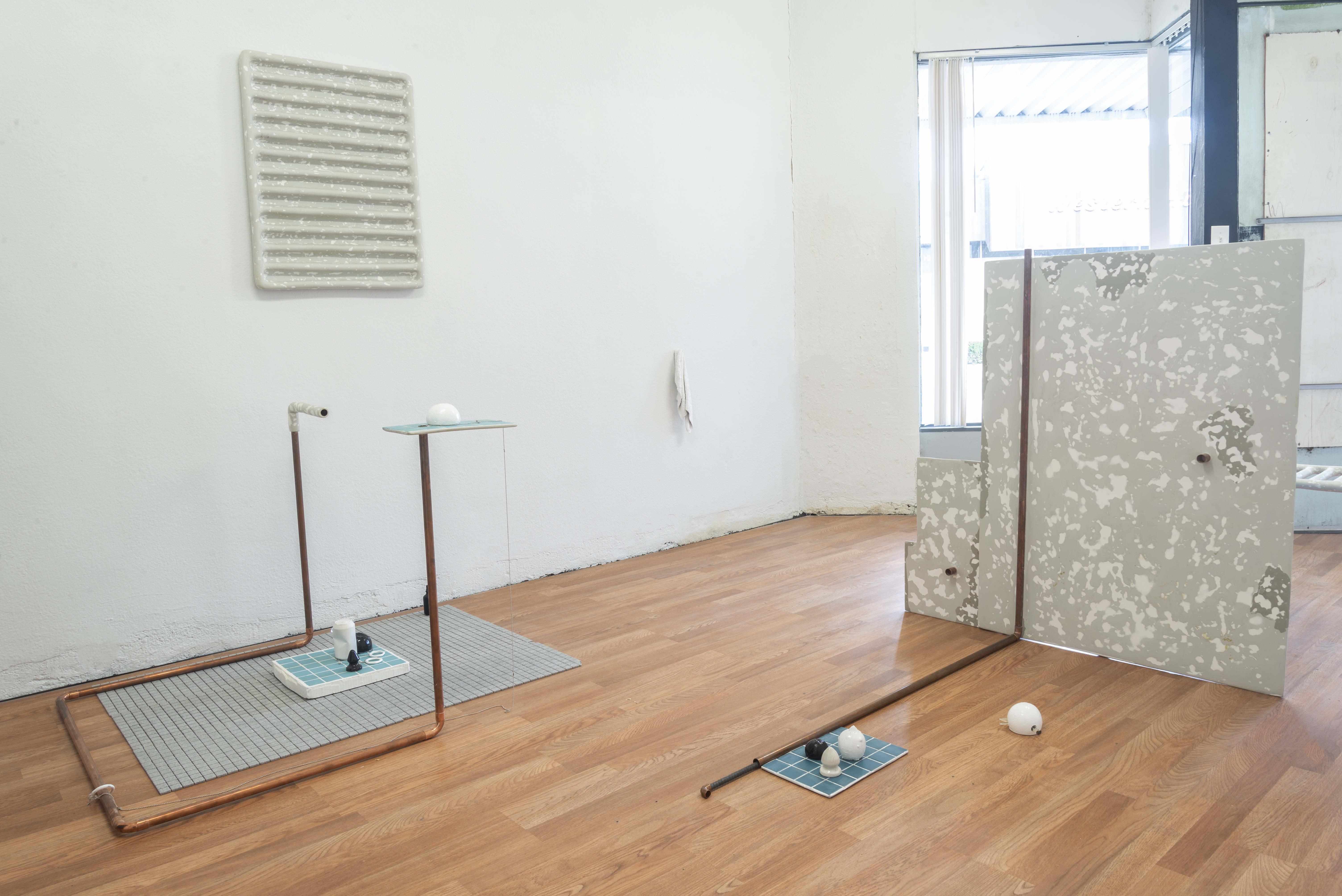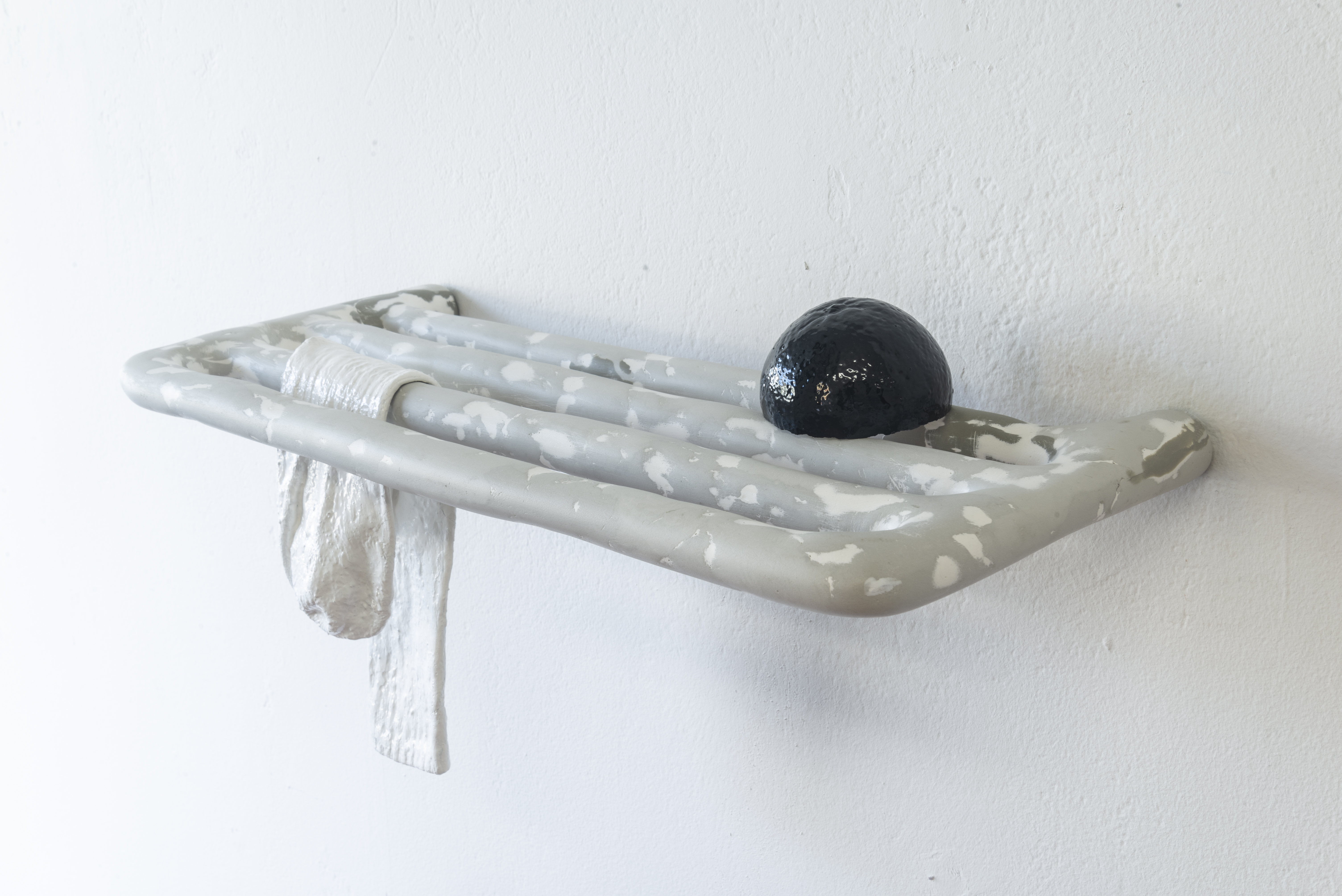

All photos by Jesse Ly
Elliot Doughtie: Locker Room
Review
Kevin Warth
Simultaneously familiar and peculiar, erotic and sterile, Elliot Doughtie: Locker Room employs the titular space to explore identity, the body, and memory. The installation at BasketShop Gallery in Cincinnati is not a literal translation of a locker room into the gallery space; rather, the exhibition consists of a series of vignettes spread across the floor that require viewers to crouch, loom, and squint to fully experience the work. This act of close scrutiny affirms the locker room as a site in which bodies are inevitably compared and gender is performed in a heightened state.
Upon entering BasketShop Gallery’s space, the viewer is met with a teal tile wall around 4 feet tall. In front of it sits a steel bench that is draped with a single sock. This small scene demonstrates Doughtie’s playful materiality that is encountered throughout the exhibition; many of the objects are created from foam, plaster, and paint, twisting the viewer’s assumptions of what is hard and soft. Looking closer, it becomes apparent that the bench’s form is too irregular, too matte, and too supple to be metal. The sock, similarly, is encased in plaster and made rigid. He plays with the eye in other ways, scattering casts of oranges across the space that may appear as an anus, a breast, or a bar of soap at first glance. Further rewarding those who look closely, anal plugs sit unassumingly amongst collections of small black and white trinkets. The scenes are brought together by metal pipes that snake their way around the gallery floor and up the tile walls, either intersecting with or creating stands for the plaster objects. The coalescence of all these small moments creates an exhibition that asks the viewer not only to look closely, but to fill the gaps with their own memories and associations.
The partial walls, small scenes, and fabricated objects meld together and evoke the eccentricity of a theatrical stage, further reifying locker rooms as a performance site. They are a highly homosocial site, a term that Eve Kosofsky Sedgwick defines as a form of same-sex bonding accompanied by disdain towards homosexuality.1 We are at a vulnerable state while dressing or showering in a locker room: bodies are exposed and potentially subjected to another’s gaze. This performance of gender, along with the complicated feelings of longing and fear often associated with locker rooms, has made them a popular setting for queer pornography. In these films, desire can be expressed without repercussion, creating a queer utopia of sorts. Locker rooms, in actuality, are much more awkward and can be fraught with anxiety for LGBTQ+ individuals. Doughtie explores both the erotic fantasy and the uncomfortable reality through his installation, insisting that the locker room can inhabit contradictory truths.
Dougtie engages in a form of place-making that theorist Jack Halberstam refers to as queer space. In the book In a Queer Time and Place: Transgender Bodies, Subcultural Lives, he defines this as a postmodern practice in which queer people create “new understandings of space enabled by the production of queer counterpublics.”2 Within the context of Locker Room, the artist transforms a site that is traumatic for many LGBTQ+ individuals into a space of sexual liberation and playfulness. Just as words like queer and dyke have been reclaimed by those oppressed by them, so too does Locker Room reclaim and recontextualize the titular site. Another concept put forth by Halberstam, the trans look, aids in further unpacking Doughtie’s installation. He defines this gaze as “a mode of seeing and being seen that is not simply at odds with binary gender but that is part of a reorientation of the body in space and time.”3 Stepping into the gallery space, the viewer adopts Doughtie’s gaze and views the locker room from a different perspective, one that may shift our understanding of the space. The viewer also brings their own memories and associations to the installation, melding the two together in an experience that is unique for each individual.
Locker Room is an exhibition that whispers rather than yells and, in doing so, asks that the viewer closely consider the objects on display. Doughtie generates a new understanding of this familiar space, recontextualizing it as deeply queer and fluid and reflecting his own explorations of gender and sexuality. By identifying the odd in the quotidian, he encourages new ways of seeing and being that undermine the heteronormative gaze.
-
Elliot Doughtie: Locker Room is on display at BasketShop Gallery through January 2, 2021.
BasketShop Gallery is located at 3105 Harrison Ave, Cincinnati, OH 45211 and is open Friday through Sunday, 1-6pm. This exhibition was made possible by an ArtsWave Pride Grant.
-
Notes:
- 1. Eve Kosofsky Sedgwick, Between Men: English Literature and Male Homosocial Desire (New York: Columbia University Press), 2-3.
- 2. Jack Halberstam, In a Queer Time and Place: Transgender Bodies, Subcultural Lives (New York: New York University Press, 2005), 6.
- 3. Ibid., 107.
- Elliot Doughtie
- BasketShop Gallery
-
12.17.20
Kevin Warth (he/him) is a Louisville-based artist and art historian whose research emphasizes queer identity, alternate temporalities, and hauntology.











